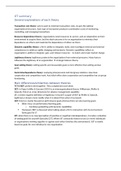OT summary
General explanations of each theory
Transaction cost theory: actors want to minimize transaction costs, to gain the optimal
organizational structure. Each type of transaction produces coordination costs of monitoring,
controlling, and managing transactions.
Resource dependence theory: organizations need resources to survive, and are dependent on their
environment to acquire them, but the ideal outcome is for an organization to minimize their
dependence on others and maximize the dependence of others on them.
Dynamic capability theory: a firm’s ability to integrate, build, and reconfigure internal and external
competences to address rapidly changing environments. Dynamic capabilities reflect an
organization’s ability to integrate, gain, and release resources – to match and create market change.
Legitimacy theory: legitimacy protects the organizations from external pressures. Many factors
influence the legitimacy of an organization strategic balance theory.
Goal-setting theory: setting specific and measurable goals is more effective than setting unclear
goals.
Social interdependence theory: analysing interpersonal and intergroup relations. How does
cooperation and competition work. And which effect does cooperation and competition has on group
functioning.
Main differences/similarities between theories
TCT & RDT: perform best together. They complement each other.
DCT: in Paper Schilke & Goerzen (2010) is an interorganizational theory. Williamson, Pfeffer &
Salancik, Fink et al. A key dimension for alliance management capability.
LT: a similar negative definition of legitimacy is found if a paper of RDT by Pfeffer & Salancik,
legitimacy is known more readily when it is absent than when it is present.
GST: theory is mainly focused on performance goals whereas there are also learning goals.
Sitkin: focus on performance/learning goals.
o Combines goalsetting with dynamic capabilities
Thompson: RDT is discussed when talking about a firm’s interaction with its environment.
Same goes for LT.
SIT: when there is no case/perception of (positive or negative) interdependence, it creates a situation
of setting goals for yourself (basically GST). Where SIT constantly relates to two (or more) individuals
or organizations working together or against each other (involves the environment). GST is mainly
based on goals for one individual or one organization.
,What is organization theory?
Whetten, 1989
What is an organization?
1) Social entities that, 2) are goal directed, 3) are designed as deliberately structures and coordinated
activity systems, and 4) are linked to distinct-external environments.
Organizational forms:
Hybrid organizations two logics: non-profit logic and profit logic.
Alliances: collaboration between independent organizations (But who is the boss?)
Project-based organizations only temporally projects.
A theory =
Focus on small part of reality
Abstracts of many other relevant aspects
Sees detail
Understanding the limited part of reality better
Cannot explain the whole story
Whetten:
What: the variables, constructs or concepts that should be explained.
How: (hypotheses) how are these factors related.
Why: (argument) the explanation why these variables are selected.
Where: is the theory possible in terms of geography?
When: time frame, validity (the more conditions a theory has the lower the validity of a theory.
Who: for whom is the theory.
Devil’s advocate: relationship between the amount of information and how much a person can
process also called absorptive capability.
Parsimonious model: you want a model that explains a lot, but with not many variables.
Sutton & Staw, 1995
What is not a theory?
References missing the why
Data is not interpreted yet
Variables/concepts why is missing
Diagrams no explanation
Hypotheses no theory is present
Mayer & Sparrowe, 2013
Four types to integrate a theory:
Single phenomenon, two theoretical perspectives: same Y, different X’s
Two seemingly contrasting theories can appear to not be contrasting at all
Applying one theory to the domain of another theory
Two theories sharing a similar explanatory account. Somewhat same Y, definitely similar X’s.
, Inter-organizational theories – TCT & RDT
Transaction cost theory – Williamson (1981) - ‘Why do organizations exist?
First, if no organization exist, then the power of the free market (the invisible hand) would be
present. Which means that all information is available, actors are fully informed, and the market is
transparent. People follow their own interest, and if the above is possible, then maximum wealth can
be acquired. TCT claims that this is not possible, because of the people that act in their own
interest.
So, organizations exist, because the use of the market(mechanism) isn’t free.
Because people are not fully informed
People have to search to gain new products, and market exchange is costly.
The cost of using the market is higher than the cost of using organizations there are
transaction costs.
Organizations are tools to reduce transactions costs, which is the goal of every exchange
actor.
Information asymmetry: a seller has more information about a product, then the buyer. You can
solve this by including a third party.
Appropriability: the degree to which an economic actor can protect its knowledge from leakage to
other parties. Property protection, like patens, can reduce risk of uncertainty. Stronger
appropriability less likely use of hierarchical governance structure.
Four types of transaction costs:
Search costs to identify potential partners
Contracting costs (negotiations)
Monitoring costs fulfilment of agreed terms, conditions are met.
Enforcement costs (sanctioning)
Transaction cost theory states:
A way to organize transactions is through markets and hierarchies/organizations like a contract
exchange problem = you want to make long lasting contracts, so that terms do not have to be
negotiated every day, because this is costly.
Transactions costs occur when there is:
Bounded rationality = the extent someone can process information and is completely
rational. Cannot be minimized.
Opportunism = seeking self-interest with guile (sneaky).
The model states: the level of uncertainty, the level of frequency and the level of asset specificity
influences the choice of the governance structure.
Governance structure = an institutional arrangement that coordinates and controls economic
transactions between actors. They minimize transaction costs. Not everybody is an organization
because there needs to be a balance between costs of buying (outsource) and the cost of doing it
yourself (insource). Specific combinations of governance mechanisms are combined:
Ownership rights: license (right to use, not own)
Pricing mechanisms (output and input pricing)




